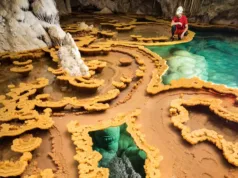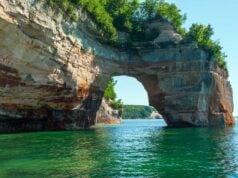Huanglong Scenic Valley, also known as Huanglong National Scenic Reserve, is a breathtaking natural area located in the northwestern part of Sichuan Province, China. It is renowned for its stunning alpine landscapes, vibrant blue pools, cascading waterfalls, and unique limestone terraces.
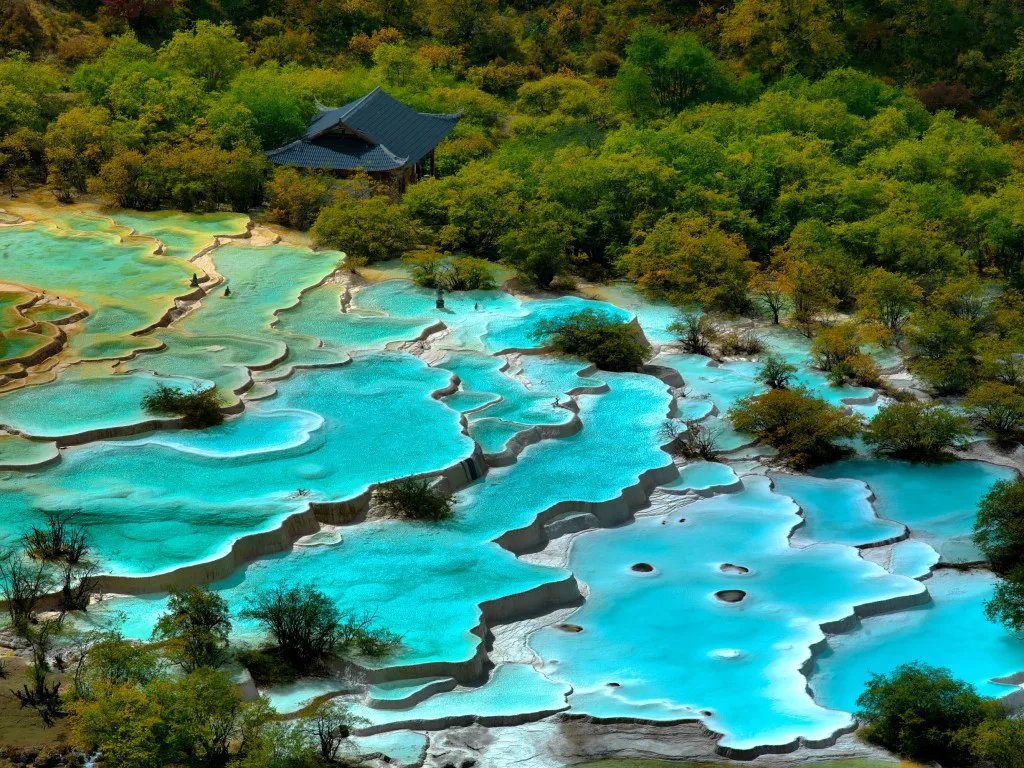
Location: Huanglong Scenic Valley is situated in the southern part of the Min Mountains, approximately 50 kilometers (31 miles) north of the well-known Jiuzhaigou Valley in Sichuan Province. It is part of the larger Huanglong and Jiuzhaigou Scenic Area, which is a UNESCO World Heritage Site.
Natural Wonders: The most iconic feature of Huanglong is its extensive, colorful travertine terraces. These terraces are formed by the deposition of minerals carried by the water that flows down from the snow-capped peaks, creating a series of striking, tiered pools and cascades. The colors of the pools range from turquoise to deep blue, and they create a surreal, otherworldly landscape.
Flora and Fauna: Huanglong is home to diverse ecosystems, including virgin forests, wetlands, and meadows. It provides a habitat for several endangered species, such as the giant panda and Sichuan golden snub-nosed monkey. The park is also a sanctuary for various rare and protected plant species.
Activities: Visitors to Huanglong can enjoy a variety of activities, including hiking along the wooden boardwalks and trails that wind through the terraces and forests. The park’s trails offer picturesque views of the stunning landscape. In winter, visitors can enjoy skiing in the area.
Cultural Significance: In addition to its natural beauty, Huanglong has cultural significance. It has been a sacred site for centuries and is considered a holy place in Tibetan Buddhism. Many Tibetan temples and pavilions can be found in the area, adding to the cultural charm of the valley.
Visitor Facilities: The park has facilities for tourists, including visitor centers, restaurants, and souvenir shops. It’s important to note that there are restrictions on the number of daily visitors to help preserve the fragile ecosystem, so it’s a good idea to plan your visit in advance.
Best Time to Visit: The best time to visit Huanglong is in the spring, summer, or autumn when the weather is mild and the landscape is in full bloom. However, the terraces can be equally mesmerizing in winter when they are covered in snow.
Access: The nearest airport is Jiuzhai Huanglong Airport, which provides convenient access to the valley. From there, you can take a bus or taxi to reach Huanglong Scenic Valley.
Huanglong Scenic Valley is a natural wonder that offers a unique and unforgettable experience for nature enthusiasts, photographers, and anyone seeking to explore the beauty of the Chinese countryside. Its combination of stunning landscapes and cultural significance makes it a must-visit destination in China.
Geological Features of Huanglong Scenic Valley
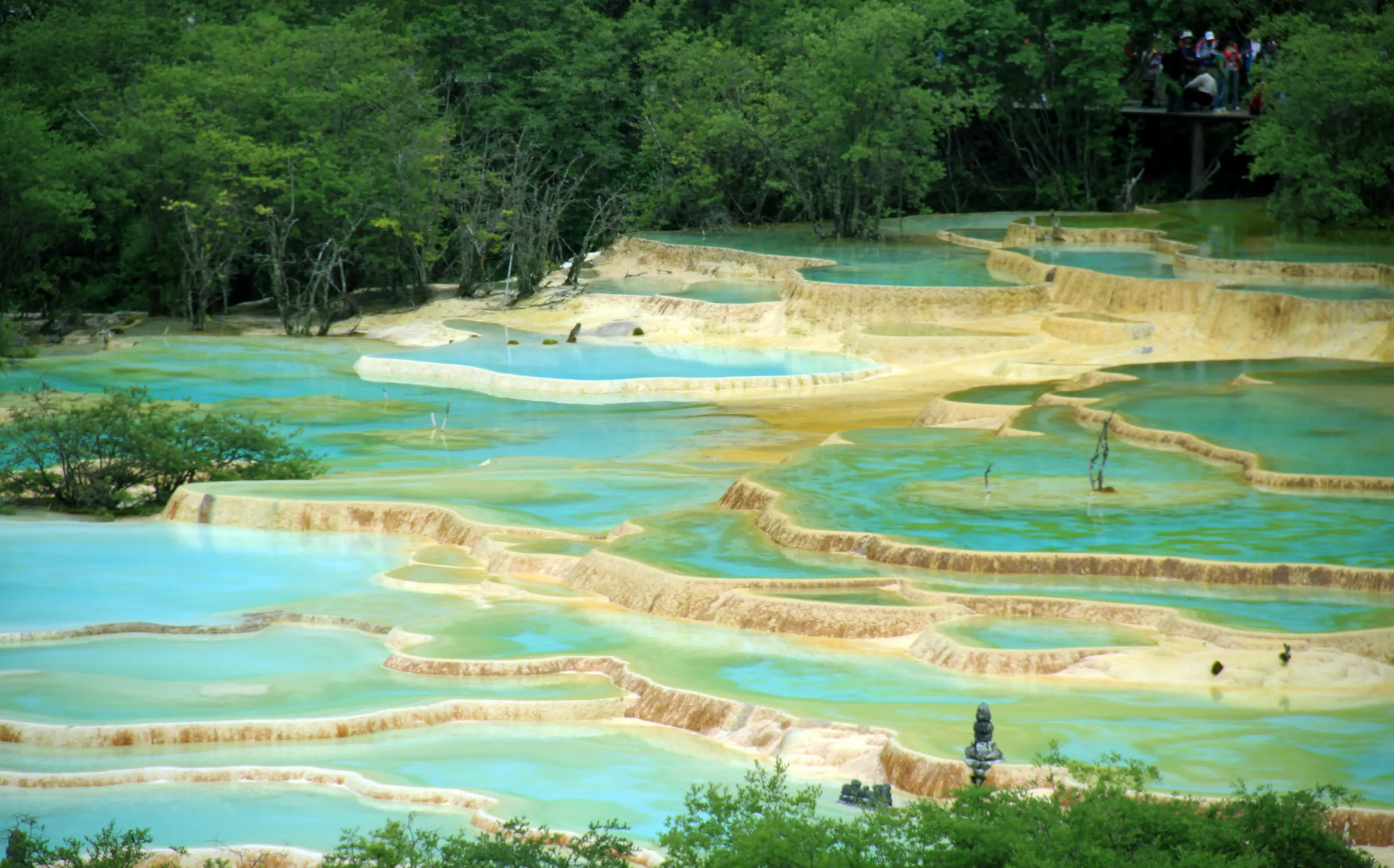
Huanglong Scenic Valley boasts a range of remarkable geological features that contribute to its unique and picturesque landscape. Some of the prominent geological elements include:
Travertine Pools: The travertine pools in Huanglong are one of the most distinctive geological features. They are formed through a natural process of calcium carbonate deposition. Spring water, rich in minerals, flows down from the mountains and over time, the minerals are left behind, creating tiered pools. These pools have a series of small dams and cascades that give the landscape a terraced appearance.
Terraces and Cascades: The entire valley is characterized by intricate terraces and cascades formed by the ongoing mineral deposition process. The cascades are created as water flows down the terraces, creating beautiful, layered landscapes. The interplay of the terraces and cascades is a key geological attraction in Huanglong.
Colorful Ponds: The vivid and diverse colors of the ponds are another geological marvel. The water in these ponds appears in various shades of blue, green, and turquoise. These stunning colors are the result of the unique mineral composition in the water and the interaction of sunlight, which creates an ethereal, almost surreal appearance.
Karst Landscapes: While karst topography is more commonly associated with areas like Guilin in southern China, Huanglong also exhibits karst features in the form of limestone terraces and sinkholes. The dissolution of limestone over time has contributed to the creation of these fascinating geological formations.
These geological elements are a result of the dynamic interaction between water, minerals, and the local geology of the region. The combination of travertine pools, terraces, cascades, colorful ponds, and karst landscapes gives Huanglong Scenic Valley its distinctive and captivating appearance, making it a geological wonder and a UNESCO World Heritage Site.
Geological Features’s Formation
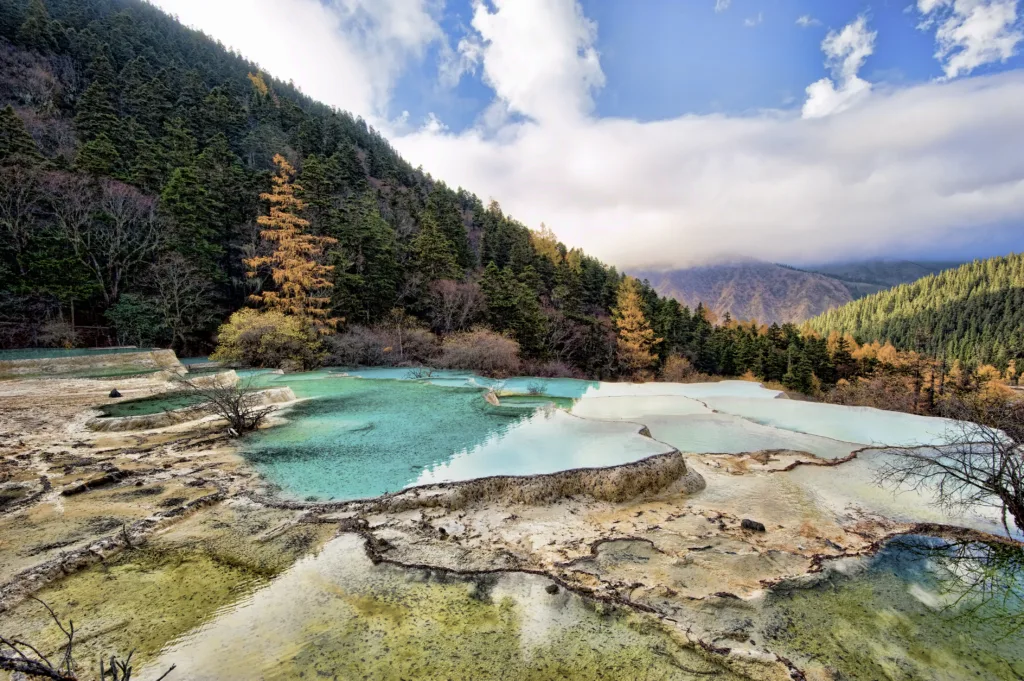
The geological features of Huanglong Scenic Valley are a result of various natural processes over thousands of years. Here is a brief overview of the formation of the key geological features in the valley:
- Travertine Pools: The travertine pools in Huanglong are formed through a process known as chemical precipitation. It begins with the water that flows down from the surrounding snow-capped mountains. This water is rich in dissolved calcium carbonate due to the dissolution of limestone in the region. As the water travels downhill, it encounters different obstacles, such as plants and rocks, which release carbon dioxide and trigger the precipitation of calcium carbonate. Over time, these deposits accumulate and give rise to the tiered travertine pools, creating the unique terraced appearance of the landscape.
- Terraces and Cascades: The terraces and cascades in Huanglong are a direct result of the formation of travertine pools. As the water flows over the travertine deposits, it naturally creates these cascading terraces. The terraces can vary in size and shape, and they often give the appearance of a series of miniature waterfalls. The continual flow of water ensures that these terraces and cascades continue to evolve and change.
- Colorful Ponds: The vibrant colors of the ponds in Huanglong are a product of various factors. The mineral composition of the water, primarily calcium carbonate and other dissolved minerals, plays a crucial role in determining the colors. Additionally, the interaction of sunlight with the mineral-rich water creates a stunning
display of colors. The different hues, which range from deep blue to turquoise, are a visual delight and add to the unique beauty of the valley.
- Karst Landscapes: The karst landscapes in Huanglong are a result of the dissolution of limestone. Limestone is a soluble rock, and over time, the action of rainwater, snowmelt, and underground springs has gradually dissolved the limestone, creating unique features like sinkholes and underground channels. This karst terrain, in combination with the deposition of travertine, contributes to the valley’s diverse and captivating geology.
Overall, the geological features of Huanglong Scenic Valley are the outcome of a complex interplay of geological processes, including chemical precipitation, dissolution of limestone, and the continuous flow of mineral-rich water. These natural processes have shaped the valley’s terraces, cascades, colorful ponds, and karst landscapes, making it a geological wonder and a place of stunning natural beauty.
History and Culture
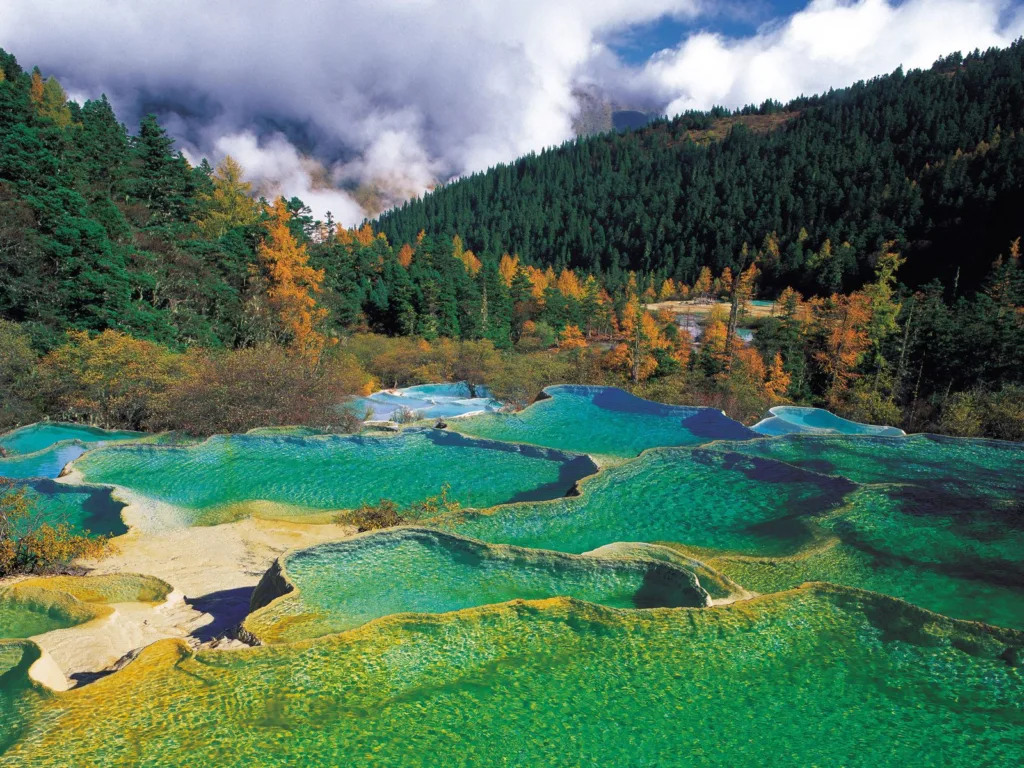
Huanglong Scenic Valley has a rich history and cultural significance in addition to its remarkable natural beauty. Here are some key aspects of the history and culture of the area:
1. Ancient History: The history of Huanglong dates back to ancient times. It has been a sacred and revered site for various cultures, particularly Tibetan Buddhism. The area has been inhabited for centuries, and several Tibetan villages exist in the vicinity.
2. Tibetan Influence: The region surrounding Huanglong has a strong Tibetan cultural influence. Many Tibetan temples and pavilions can be found in the valley, and the local architecture, clothing, and customs reflect Tibetan traditions. The valley is considered a holy place in Tibetan Buddhism, and it has been a pilgrimage site for Tibetan Buddhists for generations.
3. Religious Significance: Within the valley, there are several Buddhist temples and monasteries, such as the Zhaga Water Temple and the Mouni Temple. These sites are places of worship and reflection for both locals and visitors. Pilgrims often visit these temples to pay their respects and perform religious rituals.
4. UNESCO World Heritage Site: In 1992, Huanglong, along with the nearby Jiuzhaigou Valley, was designated as a UNESCO World Heritage Site. This recognition acknowledges the outstanding natural beauty and ecological significance of the area, as well as its cultural importance to the Tibetan people.
5. Conservation and Protection: Huanglong’s cultural and natural heritage has been under protection and conservation efforts to preserve its unique features. The management of the area aims to balance tourism and environmental preservation to ensure that future generations can continue to enjoy its beauty and cultural significance.
6. Local Communities: The area around Huanglong is home to local Tibetan and Qiang communities. Visitors can experience the rich traditions, cuisine, and way of life of these indigenous peoples. The cultural exchange with these communities is an enriching aspect of a visit to Huanglong.
7. Festivals and Events: Throughout the year, various cultural events and festivals take place in the region. These may include traditional Tibetan celebrations, dances, and religious ceremonies. Attending these events can provide valuable insights into the local culture and traditions.
Huanglong Scenic Valley’s history and culture are deeply intertwined with its natural beauty, making it a multifaceted destination that offers a blend of breathtaking landscapes and a rich tapestry of cultural heritage. Visitors have the opportunity to explore the spiritual and historical significance of the area while enjoying its stunning geological features.
Visitor Experience of Huanglong Scenic Valley
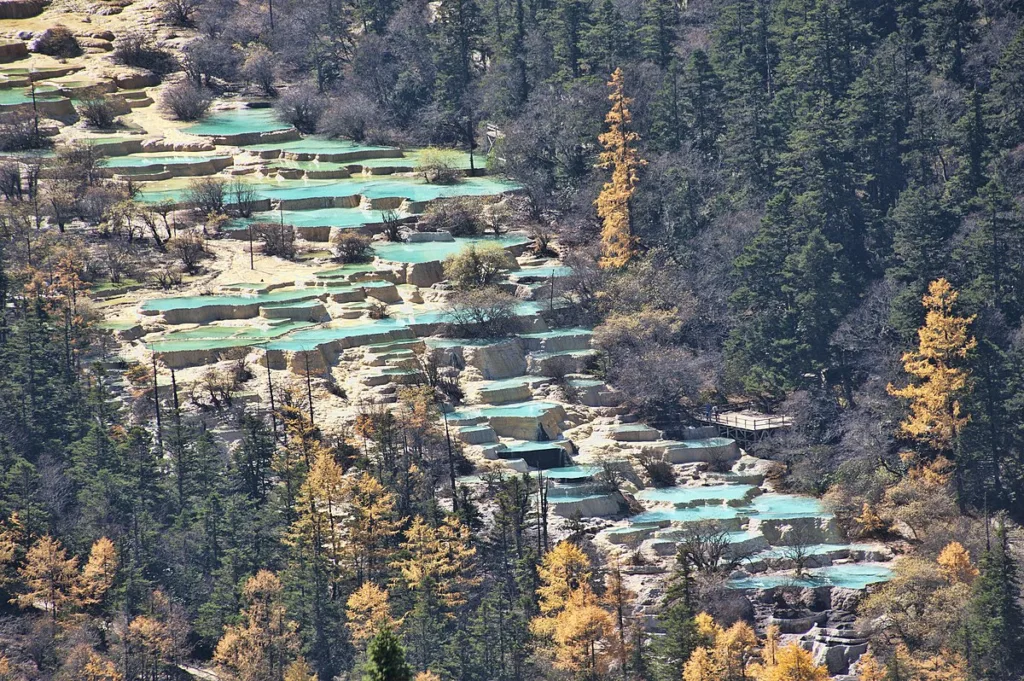
The visitor experience at Huanglong Scenic Valley is both awe-inspiring and culturally enriching. Here’s what you can expect when visiting this remarkable destination:
- Scenic Beauty: The primary draw of Huanglong is its stunning natural beauty. As you explore the valley, you’ll be treated to a breathtaking landscape of colorful travertine pools, terraces, cascades, and lush forests. The vivid hues of the ponds and the surreal karst formations create a unique visual spectacle that is a photographer’s dream.
- Hiking and Exploration: Visitors can explore the valley via a network of wooden boardwalks, trails, and pathways. These well-maintained routes allow you to traverse the terraces, encounter cascading waterfalls, and enjoy close-up views of the vibrant pools. Hiking in the valley provides the opportunity to connect with nature and immerse yourself in the remarkable geological features.
- Cultural Encounters: Huanglong is not just about natural beauty; it also has a rich cultural heritage. You can visit Tibetan temples and monasteries, witness local rituals, and interact with the indigenous Tibetan and Qiang communities. These cultural encounters offer insights into the spiritual and daily life of the people living in the area.
- Photography: The valley is a paradise for photographers, both amateur and professional. The ever-changing colors of the ponds, the striking terraces, and the surrounding landscapes provide endless opportunities for capturing the beauty of the valley.
- Conservation Awareness: Visitors can learn about the conservation efforts in place to protect the fragile ecosystem of Huanglong. The restricted number of daily visitors and guidelines for responsible tourism are designed to preserve this natural wonder for future generations.
- Local Cuisine: Savoring local Tibetan and Sichuan cuisine is an integral part of the visitor experience. You can sample traditional dishes and flavors in the nearby villages or at local restaurants within the park.
- Festivals and Cultural Events: Depending on the timing of your visit, you may have the chance to participate in or witness local festivals and cultural events. These provide a unique opportunity to engage with the cultural traditions of the region.
- Visitor Facilities: The park offers visitor centers, restrooms, and places to purchase refreshments and souvenirs. It’s important to adhere to park regulations and be mindful of the environment during your visit.
- Seasonal Variation: The experience at Huanglong can vary greatly depending on the season. Spring, summer, and autumn offer mild weather and lush landscapes, while winter transforms the valley into a snowy wonderland, making it a year-round destination for different types of experiences.
- Respect and Responsible Tourism: While visiting, it’s essential to respect the natural environment and the local culture. Stay on designated paths, follow park rules, and be mindful of the fragility of the travertine terraces.
Huanglong Scenic Valley offers a unique blend of natural beauty, cultural heritage, and outdoor activities. It’s a place where you can immerse yourself in a world of geological wonders and cultural richness while enjoying a memorable and enriching visitor experience.


























